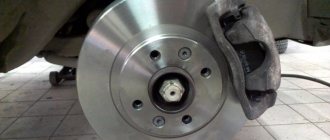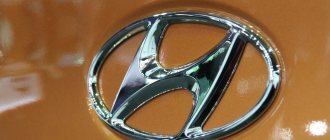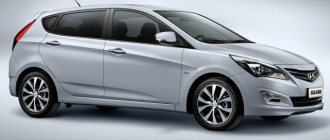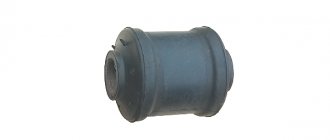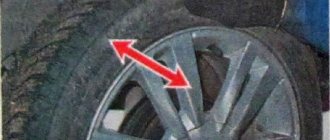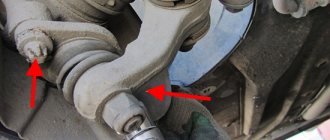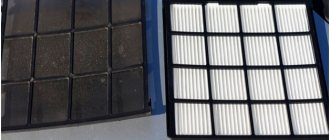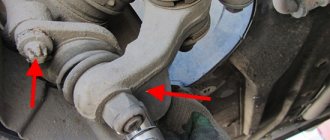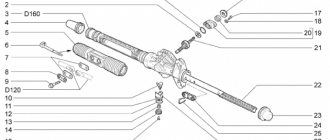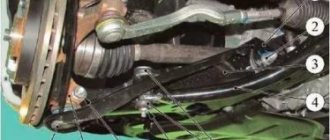Many car owners are interested in the question of what is the rear suspension of the Hyundai Solaris
?
To know the answer to this question, you need to understand the design features of this element of the car. This issue will be discussed in detail in today's article. After carefully studying the material presented, you will be able to disassemble the rear suspension of the Solaris,
without the help of qualified mechanics.
Components
The rear suspension ensures smooth movement of the car, simultaneously leveling out unevenness in the road surface.
In fact, the front suspension design is more complex than the rear suspension. It will be useful for a novice car enthusiast to have an understanding of the structure and operating principle of this mechanical element. Solaris rear suspension consists of:
- Beams, which are the main element;
- Lever fastening element;
- Shock absorber;
- Spring element;
- Lever;
- Hub unit;
- Pads on the bottom and top of the spring;
- Buffer washers.
The rear suspension of Solaris is semi-independent spring type. Its design includes a reinforced beam and shock absorbers. The levers are equipped with edges on which the wheel axles and support clamps are located. In the front part, the levers are equipped with welded bushings, where there are silent blocks connecting the beam and the body. Springs act as elastic elements.
Additional Information
Based on the data provided, one can guess that dismantling and installing individual suspension parts in a Hyundai should not cause difficulties. The main thing is to have the proper equipment.
Today, many craftsmen are engaged in refining the suspension. Such work involves installing new parts of higher quality. They often install reinforced springs, based on the fact that domestic roads cannot boast of high quality.
It is appropriate to modify the suspension only if there is a need for it. For example, when the car has to drive on bad roads.
As a rule, pointless suspension upgrades lead to increased costs, and there is no point in spending money just like that.
The rear suspension is semi-independent with an elastic beam of U-shaped section, spring with double-acting telescopic shock absorbers. Flanges for attaching the rear wheel axles and brake shields, as well as brackets for spring supports, are welded to the suspension arms. At the front, the levers are equipped with welded bushings into which silent blocks are pressed to connect the beam to the body.
Spring
In the Solaris rear suspension, the springs are supported by special gaskets made of high-quality rubber. In the Solaris rear suspension, the lower coil has a smaller diameter in contrast to the upper one.
Springs differ in classification, which is determined by stiffness indicators. To define a class, constructors color elements in different colors. Each side uses springs of the same class and model. When replacing springs, you cannot install elements that differ from the class of previously installed parts. The function of a limiter during compression is performed by buffers installed in the center of the upper support element.
The shock absorbers are equipped with special eyes at the bottom and top. They contain metal or rubber hinges. In the inner part of the hinge there is a bushing with a passing bolt, like a fastening element between the body and the shock absorber. The front suspension of the Hyundai Solaris has bearings located in the hub unit. This unit does not require regular lubrication, and if it breaks, it must be replaced.
The rear axle wheels have a fixed position and do not allow for adjustment. They can be checked using special equipment to identify discrepancies with the norm. If, after checking, discrepancies with the initial values are revealed, then it is necessary to diagnose these parts.
Suspension features
The car is a long-term project of Korean engineers, which has received many flattering reviews throughout its existence. However, the manufacturer's transition to new equipment made it possible to present a completely different Solaris to the world. The first car was characterized by original features that indicated the designer's ability to think outside the box.
The new product captivated many with the performance of its power units, as a result of which no one paid much attention to the presence of any shortcomings in the operation of the vehicle. However, over time, many car owners became less happy and satisfied with the use of the car and demanded that management carry out improvements.
The front suspension of the Hyundai Solaris received most of the complaints. According to car owners, it could only work well on perfectly smooth surfaces. If you had to travel across the expanses of Russia, the driver was faced with many problems with the suspension.
More on the topic: We bring the updated Hyundai Solaris into the lair of competitors. Test drive hyundai solaris - DRIVE
What have manufacturers changed?
The company's management does an excellent job and gladly takes into account the wishes of its clients. As a result, with each restyling of the car, the manufacturer tries to remove all the shortcomings.
Hyundai's front suspension was made in the form of a unique design using struts from MacPherson. The type of suspension is independent, due to which it provides:
- excellent grip on the road surface;
- excellent handling both when cornering and on flat sections of the route;
- high reliability and traffic safety.
The car's dynamism on the road is achieved through the use of new energy-intensive shock absorbers by the company's engineers. The springs, along with the shock absorbers, have received a greater degree of rigidity.
As a result, we managed to get a car that perfectly overcomes bad road sections. The new version of the car, unlike the previous model, moves smoothly and quietly, easily avoiding various bumps in the road surface. A revision of the car's suspension design made it possible to reduce the previously developing buildup.
"Hyundai-Solaris", from 445,000 rubles, CAR from 4.21 rubles/km
Has Solaris become tougher? Perhaps. Not enough, however, to shake out the soul. I would be happy with just such chassis settings. Although my fellow traveler doesn’t seem to be very happy: at the next speed bump the car shook noticeably, and my colleague, snoring peacefully in the passenger seat, looked reproachfully in my direction. Still, it is a thankless task to try to please a sophisticated public.
Other features of Solaris remained with him: there are few of them, as before, but they still exist. The sound insulation of the arches leaves much to be desired, and you will have to put up with the low ceiling above the sofa. The 1.4-liter engine does not come with side and window airbags, and convenient central locking with remote control becomes available at least in the expensive “Comfort” version.
Main types of suspension repairs
Despite the excellent assembly of the car, the most susceptible to repair elements are still the front suspension arms and shock absorbers. If extraneous knocking noises appear while driving or uneven tire wear occurs, it is necessary to repair the front suspension of the Hyundai Solaris.
- raise the front;
- place a safety support;
- remove the wheel;
- then you need to remove the ball pin nut;
- the finger is pressed out using a puller;
- the lever is disconnected from the steering knuckle;
- Next, you need to remove the nut of the front bolt securing the lever to the cross member;
- after removing the nut, it is necessary to remove the bolt from the silent block;
- then also remove the rear fastening bolt and nut;
- then the lever assembly with the ball is removed;
- Installation of the part is carried out in the reverse order.
After replacing the lever, be sure to set the wheel angle to . If, after replacing the lever, the knocking does not stop, you need to check the front suspension shock absorber. To remove it you must:
- it is necessary to place anti-roll bars under the rear wheels of the car;
- loosen the front wheel nuts;
- Under the hood, remove the protective caps on the shock absorber fastening nuts;
- loosen the nut - this is done with two keys, one holds the rod from turning, the second key unscrews the nut itself;
- remove the top nut;
- remove the thrust washer;
- lift the front end and remove the wheel.
On a note! When removing the shock absorber on the right, you first need to unscrew the bolt of the wheel rotation sensor bracket, then remove the wires. If the car has an ABS system, then sensors are installed on both sides.
- then the nut of the upper stabilizer hinge is unscrewed and the pin is removed;
- Next, remove the bolts securing the strut to the knuckle;
- after removing the bolts from the holes, the fist is moved to the side and the stand assembly is removed;
- then you need to compress the spring using a clamp and unscrew the rod nut;
- then the support bearing is removed;
- the support cups are removed from the rod;
- then the spring and protective rubber are removed;
- if the rack has various defects in the form of streaks or cracks, it must be replaced;
- Before installing the shock absorber, it must be bled to ensure proper operation. Pump until the rod is completely lowered and raised. There should be no failures;
- assembly is carried out in reverse order. It should be noted that the spring is fixed at its end in a special seat.
The front shock absorbers must be replaced in pairs. After the repair, you will need to adjust the wheel alignment.
DIY front suspension upgrade
The restyling carried out in 2014 gave Solaris many advantages over its predecessors. However, not every car enthusiast was pleased. As a result of this, many car owners began to use all sorts of independent modernization methods, as a result of which the front suspension of the Hyundai Solaris is slightly changed. Tuning it consists of the following methods.
More on the topic: Tires for Hyundai Solaris: how to choose, sizes, pressure
To upgrade, it is necessary to replace the front shock absorbers. Drivers must install a KIA Soul part instead of the original one. This method is the most popular.
- Initially it is necessary to jack up the car;
- then the wheel is removed;
- the standard shock absorber is removed;
- the shock absorber from Kia is slightly longer, so it is necessary to trim it in line with the original part of the car;
- then the new shock absorber is pumped (4 passes);
- car assembly.
Thanks to this tuning method, it is possible to achieve high rigidity on bad roads; in addition, the car acquires improved qualities in the form of stability and controllability.
Another method of modernization is the use of purchased elements. The unique design is called a cube suspension. Despite the little popularity of the pendant, many speak flatteringly about its performance. The suspension is based on the use of front springs, the strength of which is much greater than conventional ones. Thanks to this, the car becomes even more dynamic and controllable.
The right to choose remains with the driver. It is he who decides whether to upgrade the suspension and get a completely different car in terms of characteristics, or save money and spend money on repairs.
Upgrading the Solaris suspension at home is of interest to many car owners. How to do it yourself, what tools are needed for this and what spare parts to use will be discussed in detail in this material.
Almost every owner of a Hyundai Solaris, after using the car for some time, asks the question: how to upgrade the suspension? This is not difficult to do, but it is important to approach the task responsibly and competently. Problems with the Hyundai Solaris chassis usually arise when driving over uneven surfaces, of which there are a lot in our country. Changes in the suspension can be different and they usually depend on the capabilities and requirements of the owner for his own car.
Rack diagnostic methods
It happens, although quite rarely, that the strut makes extraneous sounds due to its internal problems, for example, the nut that holds the piston has become unscrewed. However, this does not cause knocking. When driving, the car sways and controllability decreases. In this case, replace the strut and repair the suspension.
Various shock absorber breakdowns are the consequences of its improper use. The oil in these systems must have a special specific viscosity, which also depends on the air temperature. Having warmed up the engine, the driver immediately takes off, but the oil in the rack has not warmed up. If it’s frosty outside, then the viscosity in the stand is too high. In this case, thin and very fragile parts fail.
Thick oil may also not be related to the weather. Sometimes excessively thick liquid is poured into shock absorbers. This is done to increase the resistance force and so that the oil does not “run away”. But as a result, stability and controllability deteriorate, because hard does not mean good.
Existing problems
On all forums dedicated to Hyundai Solaris, car owners discuss design flaws in the rear suspension. The automaker assures that after
Hyundai Solaris suspension
In recent models, the wishes of motorists have been taken into account and everything has been corrected, however, models of early years of production require certain changes. Owners make especially many complaints about the yaw of the car when driving at speeds over 80 km/h. Experts determined that this was due to an unsuccessful mounting design for the rear shock absorbers.
More on the topic: How to choose wheels for Hyundai Solaris
We all realize that a car that is ideal in every sense does not exist, but everyone wants to have a car with a minimum number of shortcomings. After a certain operating period, the wheel bearings may become weak, and the steering rack may also begin to hum. Subsequently, the steering wheel will begin to beat, and the tips will wear out faster. To avoid the problem, certain elements need to be modified.
Shock absorbers are installed at a certain angle, which causes an inevitable increase in loads and inertia forces. Installing shock absorbers strictly vertically will reduce suspension travel, but will reduce loads and inertial moments. These simple modifications usually involve car owners upgrading the Solaris suspension.
Rear shock absorbers for Hyundai Solaris
Due to problems with the rear shock absorbers on the Hyundai Solaris, the suspension was modified several times. As a result, it became more rigid, and it was possible to minimize body sway at high speeds. After February 2014, the designers simply clamped them down, and the variant received the designation L-002; these shock absorbers have a green mark. The car can drive more confidently on crushed stone, dirt roads and other surface options that are extreme for a city car. When installing, it should be taken into account that the design does not provide for the division of shock-absorbing struts into left- and right-hand ones. The original numbers by year of manufacture and dimensions are indicated in the table.
Rear shock absorber on a car.
Original numbers and dimensions of Hyundai Solaris rear shock absorbers
Rod diameter, mm
Case diameter, mm
Length in compressed state, mm
Rod stroke, mm
Before 08/15/2011 After 08/15/2011
How to modify the Hyundai Solaris suspension?
It is necessary to move the shock absorber mounts by making new fasteners for the assembly. They are made so as to obtain four points for attaching the lower point of the shock absorber. This will allow you to select the optimal suspension geometry for specific operating conditions. Note that such a modernization of the Hyundai Solaris suspension increases the chances of breaking through the suspension. This can be eliminated by installing other springs.
Initially, to avoid breakdown, car owners made inserts from dense rubber, inserting them between the coils of standard springs, but this solution was not very effective. After experimenting with springs of different brands from other cars, optimal results were achieved using springs from VAZ 2108 and 2110. They should be slightly shortened by cutting off approximately 2.7 parts of the coil and bending the outer part of the cut coil.
https://www.youtube.com/watch?v=L5lZER2ZvUw
This upgrade produces good results, but it is important to install lower spring bumpers to act as a center for the springs. installation of standard barrel-shaped coil springs for Hyundai Solaris significantly improves the technical characteristics of the chassis. Depending on the required ground clearance, you can trim the springs a little more or less.
More about Solaris
- How serious are the problems of the Hyundai Solaris?
- Changing the oil in automatic and manual transmissions Hyundai Solaris
- Where is the VIN number for Hyundai Solaris?
- Hyundai Solaris check light is on – Auto magazine Acord-Auto
- DIY Hyundai Solaris suspension repair
- Renault Logan – Renault Logan is the best car What is better Renault Logan or Hyundai Solaris
- Modifying the Solaris suspension with your own hands || Modification of the Solaris suspension
- How serious are the problems of the Hyundai Solaris?
- Hyundai Solaris rear suspension design
- Which is better: Kia Rio or Hyundai Solaris
